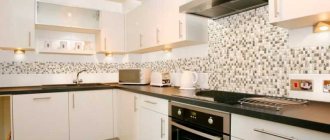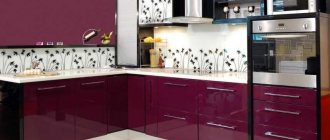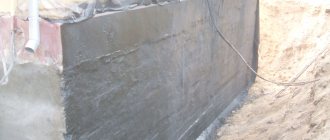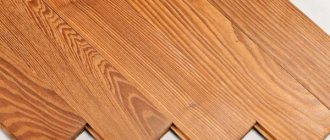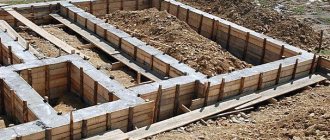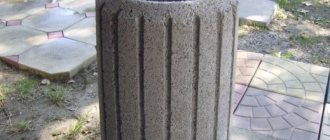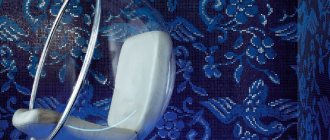A kitchen apron gives the cooking room a special charm that can hardly be achieved in any other way. This concept should not be confused with an element of a chef's clothing. An apron, in this case, is an interior design option that “encircles” a wall or part of it.
It helps not only aesthetically, but also in terms of dividing the kitchen into functional areas. An apron makes this much easier. This is why it has become so popular in kitchens all over the world.
Decorating a mosaic kitchen apron
It can be decorated from various materials, such as ceramic tiles. It all depends on the general style of the room, what the owners’ budget is, and what the features of the wall are.
But, of course, the apron will be as aesthetically pleasing as possible if it is made of a material such as mosaic.
This option for kitchen design turns out to be very aesthetic, it looks interesting and original. This is why mosaics in kitchen design are becoming more and more popular.
It has been used to decorate various rooms for a long time, but recently it has been undeservedly forgotten. In terms of beauty and effectiveness, there can hardly be anything more beautiful than mosaic. So in the last few years it has been experiencing a real renaissance.
Review of different types of mosaics with examples of interiors
Form
A mosaic kitchen apron can have different shapes:
- square;
Decorating the backsplash with mosaic tiles in black with light grout
- rectangular;
- irregular shape for stones;
Material
The size of the tile and some of its performance characteristics depend on the material from which it is made.
- Glass
is the most popular material for mosaics.
Glass blocks can have different designs not only in color. There are matte, glossy, translucent and transparent, with the addition of sparkles, foil, etc.
One of the varieties is smalt
. Even more durable material made from pressed colored glass. It is distinguished by the heterogeneity of shade in different tiles and its saturation.
Another glass-based variety is mirror mosaic
. Looks impressive in art deco and hi-tech interiors. Relevant for small kitchens, because... increases the volume of the room due to reflection.
- Ceramic
. The second most popular option. Affordable, has a wide selection of colors and shapes. Has the same properties as regular tiles.
- Porcelain tiles
. Mosaic tiles made of porcelain stoneware will be more expensive than glass and ceramic ones, but will be more affordable compared to stone. Looks more natural.
She has a large selection of textures: rough, glossy, matte, embossed. But in terms of color choices it is inferior to glass mosaics.
- Stone
. Kitchen mosaics made from natural minerals (onyx, marble) look and are expensive. Chips made from this material are larger than, for example, glass. Suitable for traditional interiors and will appeal to those who love natural materials in decoration.
- Mother of pearl
. It is distinguished by beautiful, iridescent tints of color and light. For those who like this design, but do not have the funds to buy natural material made from real mother-of-pearl, there is the opportunity to purchase a good imitation made from smalt.
- Metal
. The effect of steel shine is achieved through treatment with a layer of stainless steel. When making tiles, plastic and rubber are added to ceramics.
This design is suitable for high-tech and loft styles.
From mosaics you can create various compositions with subjects, ornaments, patterns.
Mosaic panel on the kitchen apron
You can use a single-color finish or make a mix of different shades, a gradient or stretch.
Black and white color combination in the design of a mosaic apron
Another design option is to use grout that contrasts with the color of the tile.
Advantages and disadvantages
Mosaic tiles are like any other interior design element. It has both advantages and disadvantages. Only you can decide whether to use a mosaic backsplash in your kitchen.
The following factors speak in favor of installing this design:
- High aesthetics , originality of the resulting apron.
- Durability . Mosaic tiles are a durable material that is difficult to damage or destroy; scratches and other problems are practically invisible on it.
- Filling the room with light , since many of the mosaic materials have a mirror effect, which helps to enhance the lighting in the room.
- Perfect for a kitchen in any style , from modern to classic.
- Caring for a mosaic apron requires the most primitive : it is enough to clean it with a cloth from dirt and dust.
But there are also factors that speak against the use of mosaic as a finishing material:
- High price. Almost any similar finishing material will cost less;
- Difficult to install. Since the mosaic has small dimensions, it is very difficult to lay it, this requires certain qualifications and experience;
- If one of the elements is damaged, problems may arise in finding a completely similar one..
A mosaic apron definitely has more advantages than disadvantages, but this design is suitable mainly for people with a fairly large budget for renovation work.
This is due to the considerable price of the material itself, as well as the fact that you will have to pay a certain amount to the craftsmen who, most likely, will do the installation.
Grouting joints
The difference between the commercially available compounds used for grouting joints between mosaic chips lies in their base. It can be cement or epoxy.
- Cement grout is cheaper, easier to apply and spread over the surface of the finished panel. Those who decide to make a mosaic apron in the kitchen with their own hands should pay attention to this option. Among the disadvantages, it is worth noting weak resistance to frequent washing and porosity. Over time, the appearance of the seams deteriorates, they darken and need updating.
- Grout made on the basis of epoxy resin has the best adhesion to the base. It has such valuable characteristics for the kitchen as the inability to absorb moisture and dirt. You can clean the seams as many times as you like, including using ordinary household detergents. The color of the seams will remain unchanged.
D
To obtain snow-white joints, epoxy grout is usually used.
The disadvantages of the epoxy composition are its high cost, as well as high demands on the skill of the mosaic layer. The drying speed of the finished composition is very high, there is no time to think, so it is necessary to act accurately and very quickly.
For someone who has never worked with this material before, it is better to choose something simpler, or first practice on a less critical area.
Adhesive compositions
The most important qualities that mosaic adhesive must have are: water resistance and antibacterial properties. Regular changes in temperature, humidity, and light should not affect the strength of the dried glue.
Tile mosaics are usually glued with the same adhesives that are used for laying ceramic floor or wall tiles. For natural stone, quick-hardening cement-based compounds or polyurethane compounds (for porous stone) are used.
For gluing glass chips, use only white tile adhesive.
Types of mosaics by size and material
The dimensions and appearance of an individual mosaic element can vary significantly. But the shape of each part is usually square, less often rectangular. This is due to the fact that elements of this form are much easier to put together, creating interesting compositions.
Mosaics for kitchen interiors can be made from different materials. Depending on what kind of raw materials were used, the price of the product varies, as well as some aesthetic characteristics.
Ceramic decorative elements are made from tiles of the same name. They are wear-resistant, can withstand high temperatures well, and are not easily soiled, which makes ceramics an excellent option for the kitchen.
Jewelry made from this material looks soft and very harmonious, giving the impression that the decoration was done by hand. True, the cost of ceramic mosaics is almost 2 times more expensive than, for example, glass, so the owner will have to spend a lot of money on such kitchen decor.
Glass mosaics are a much more affordable option, but they have their own special beauty. Glass, thanks to its small size and thoughtful fragmentation, is really durable, so you don’t have to worry that the decorative element may burst or be scratched.
There is a huge variety of design solutions that can be made using glass mosaic; it can be called a truly universal material. We recommend choosing this material if you want an original kitchen without high costs.
A mixture of glass and minerals is also often used. Such a mixture in one mosaic element looks really interesting. The effect of using precious materials is created, which automatically attracts attention.
Smalt is similar to glass in its composition (small fragments of colored glass and sand are mixed in it), but the appearance of this material differs from a glass decorative element. Smalt gives the impression of being handmade due to the fact that there is a slight difference between the shades of adjacent elements in the mosaic.
The color of an apron made of this material is very beautiful and rich! In addition, the material looks really impressive thanks to the special internal glow effect that smalt has. But such a decorative element is also not the most affordable, so you need to balance your desire with the size of your budget.
If you have a large budget for kitchen decoration, then a stone mosaic would be an excellent decoration option. A variety of stones are used to create fragments: onyx, marble and many others.
Such decor will be truly impressive; it attracts the eye and amazes with its beauty. The stone is very durable and does not require much maintenance. And the appearance of such an apron will be simply excellent.
Materials
For mosaics in modern production, a variety of materials are used, each of which has its own advantages and features. The most popular of them are worth considering in more detail.
Ceramic tile
This is one of the most popular materials for finishing a kitchen apron. It is a solid ceramic tile with a mosaic pattern applied to its front surface, or with a characteristic convex texture with slots. This material has the same advantages as conventional ceramic tiles - it is an acceptable cost with high quality.
When purchasing mosaic tiles, you can save significantly not only on the material itself, but also on its installation, since laying such tiles will cost much less than laying real mosaics. At the same time, ceramic mosaic tiles have excellent aesthetic characteristics, so it will be very difficult to distinguish them from classic mosaics after installation.
The main feature of this material is the ability to use it in creating any interior: sophisticated and strict, or pompous and bright. In addition, mosaic ceramic tiles provide a large surface area to be covered in individual fragments, which significantly reduces the presence of joints between tiles.
This is extremely important, since the further condition of the cladding itself depends on the number of seams between the tiles. Thus, mosaic tiles are an ideal option for arranging a kitchen apron.
Glass
Mosaics made from this material come in several types. To make a kitchen apron, homogeneous glass (also called Venetian) can be used. This material consists of small glass blocks made in the form of multi-colored and shiny, or dull and as if sharpened by the sea, pebbles. Bright sparkles, foil and other small materials are often added to such glass.
Venetian glass looks very expensive and attractive, it is ideal for furnishing kitchens in a wide variety of interiors. Another material for creating glass mosaics is smalt. It is a mixture of pressed glass baked in a special way. Smalt is colored during the production process by metal oxides (such as chromium, copper, cobalt, silver, iron, nickel, uranium).
In the Byzantine era, gold smalt was very popular, for the manufacture of which gold leaf was used. Smalt is highly durable, it is produced in a wide range of colors and has a rich color. A kitchen apron made of smalt will look great. Glass tiles supplemented with mineral composition.
To create mosaic tiles that resemble gemstones, glass is melted and mixed with iridium, quartz or other minerals. This mosaic is very expensive, but looks extremely luxurious and presentable. A kitchen apron made of this material has a complex color; it can shimmer and shimmer in the light.
There is also mother-of-pearl mosaic, which can also be considered a type of glass mosaic. This is an excellent decorative material that muffles and reflects the light directed at it, shimmering with all the colors of the rainbow. Perhaps this type of glass mosaic can be considered the most expensive.
Metal
As a rule, such material is made of ceramics, plastic or rubber, with a layer of metal applied to their surface, giving the mosaic a silver or golden appearance. This apron looks very attractive, while it is reliable and completely safe.
One of the advantages of this material is that it will last a very long time, since the decorative coating made of thin metal is highly durable. This mosaic is made in the form of shiny fragments about 0.6 mm thick, with the help of which the entire surface of the kitchen apron is evenly covered. This coating can imitate antique bronze or gold.
The ideal option for using this material is to create a kitchen interior in a classic or art deco style. Metal mosaic has only one drawback - fingerprints and dirty stains are clearly visible on its surface, so you will have to take care of it more carefully.
Color solutions
There are really many options regarding the choice of mosaic color. The color range is almost unlimited. Most often, monochromatic or mixed colors are chosen from various shades of the same color.
The design can be either bright or classic, restrained. Any color, even gray, takes on a new look thanks to the glow and reflection of light. Therefore, you need to choose a color depending on the overall style of the room.
Decoration options
Thus, the images formed by the mosaic can be different. Thus, anyone can choose exactly the kitchen design option that best suits them. An apron will be truly appropriate and aesthetically pleasing.
Here are the main options for images on the mosaic:
Plain. Perfect for modern kitchens and rooms in a minimalist style. A plain apron visually expands the space of the room and gives it shine, because bright elements reflect rays of light, which leads to a very aesthetic effect.
This version of the pattern is easy to assemble, so its installation will be easy. We recommend choosing white, black, coffee, beige colors for a monochromatic design.
Mix. This type of decor consists of elements that are painted in different shades of the same color. The result is a very interesting effect that is both beautiful and original. There is no particular difference in the arrangement of shades, so installation will not cause additional problems.
Abstract. Such images do not have a clear structure, but look very interesting and truly original. Abstract mosaic backsplashes are perfect for those who appreciate interesting solutions. They will be appropriate in kitchens of almost any style.
If you want to make your kitchen truly original, you can use a mosaic to lay out a specific image. It's up to you to decide which picture will decorate your kitchen.
But such a design is sure to make a strong impression on everyone who enters the cooking room. Such an apron will be more expensive and difficult to install, but the result is definitely worth the effort and money.
There are many options for decorating a kitchen using mosaics. In the case of this finishing element, the main “trick” is that even when choosing the most banal monochromatic design, the result is truly spectacular and aesthetic, the apron will look interesting.
Types of mosaic material
Glass mosaic
For the kitchen this is an ideal option. Firstly, it is easy to use and care. There are no visible stains on it if you didn’t have time to clean up before the guests arrived. Secondly, it costs less than its counterparts on the building materials market. Thirdly, it is very durable. Resistant to temperatures and abrasive surface cleaning agents.
Glass mosaic in turn is divided into:
- Glass homogeneous mosaic. These are small glass cubes or candies and can be matte or shiny. Manufacturers add glitter and foil to some models.
- Smalt. The glass is baked with metal oxides. The result is high-strength glass of rich color that glows from the inside. Smalt can easily be mistaken for mother of pearl.
- Glass with added minerals. This tile is made by mixing glass with aventurine or iridium. The surface of the mosaic becomes durable, shiny, and shimmers with all the colors of the rainbow.
Ceramic mosaic
If you want to create a special atmosphere in the kitchen, claim sophistication and individuality, you should choose ceramic mosaic tiles for laying out the apron. It imitates handmade products, is very durable, and is perfect for oriental-style interiors.
Compared to glass mosaics, ceramic ones do not have such a wide selection of shades and colors and require more grouting materials when finishing joints. At the same time, the thickness of the ceramics is impressive, it is twice as thick as glass, approximately 10 mm.
Types of ceramic mosaics:
- Matte;
- Glossy;
- Imitating stone or pebbles;
- Ugly, rough.
Stone mosaic
The main advantage of stone is wear resistance and strength. If you are building a house to last forever, then this option will definitely suit you. In order to produce stone tiles, factories use a variety of stones and minerals: marble, onyx, etc.
When purchasing stone mosaics, avoid the option of using porous and soft minerals. They are left with indelible marks from red and orange liquids. And this is not very practical for the kitchen. Stone mosaic is easy to combine with ceramics and smalt.
Porcelain stoneware mosaic
The advantage of porcelain stoneware is that it is less porous compared to stone, but retains the high strength of glass and stone together.
Unfortunately, porcelain stoneware has a very poor color palette. It is difficult to choose these tiles for an effective and individual kitchen design.
Mother of pearl mosaic
Buying natural mother-of-pearl tiles is affordable for very rich people, but everyone can appreciate its merits. Mother-of-pearl mosaic gives a feeling of comfort, dims the light, while simultaneously reflecting and scattering it. It shimmers in the sun, highlighting it with warm and spring shades.
Design Features
To summarize, the design features of a mosaic apron are as follows:
- Brightness and originality.
- Easy to care for.
- High variability of design solutions.
- A variety of materials: from natural to synthetic.
- The design is predominantly monochromatic; only a pattern or image can really stand out.
- Ideal for those who want to make their kitchen bright and original.
Conclusion
A mosaic kitchen apron will be a really interesting and appropriate option for interior design in the kitchen. It will help divide the room into zones, add originality and light.
Mosaic as a material option is suitable for those who love non-standard solutions and have a fairly large budget, since the material itself will not be cheap, and it is unlikely that you will be able to lay it yourself, so you will also have to pay the craftsmen for the work.
Choose a mosaic material that will maximally satisfy you aesthetically, financially, and will suit the characteristics of your home. Then an apron made of small elements will be a really good solution!
Sizes and shapes
The standard shape for making chips in a mosaic is a square. The elements are placed on a polyurethane mesh or flexible material (rubber, plastic).
Chips
The size of one chip can be from 1*1 cm or more. The mosaic is not produced individually, but is glued during production onto a piece of mesh or other material; its standard size is 30*30 cm, but larger or non-standard options are possible, for example, 31.5*31.5 cm. For convenience when installing the apron, the matrix can be cut.
The base is flexible; if necessary, the matrix can be cut into pieces
Among the shapes of elements other than square, the most common is the rectangle. There are diamond-shaped, hexagonal, abstract and even round chips on sale. The more standard the elements in the mosaic, the more expensive the material.
Different shapes
